Pernille Ripp's Blog, page 44
March 17, 2017
On Hygge and What It Really Is
I am not wearing wool socks right now.
There are no lit candles in my classroom.
I am not smothered in blankets, nor playing a board game with a loved one.
I am not slowing down, nor contemplating life. I have not cooked an elaborate breakfast before I started my day.
And yet, “jeg hygger” right now in my classroom. The morning is quiet and dark, I am content, I have my tea and a new day awaits.
This past year, it has been interesting being a Dane outside of Denmark. It seems as if everywhere I go, my entire culture has been distilled into one word, “Hygge.” (Not pronounced hoo-ga by the way.) Strangers have asked me for tips, my friends have shared their own experiences, and I have smiled, laughed and tried to explain that hygge and being “hyggelig” is not something you create meticulously. That yes candles may be a part of it and so are warm blankets and fires and laughter and love and books, don’t forget about books. But if you think that that is what hygge is, then you are sorely missing the point.
As the elements of hygge have been sold to the world, they have become just another form of cultural appropriation. There are, indeed, practical explanations for most of them; we wear warm socks in winter because it is cold, drafty, and sometimes dreary during our dark winters. Candles are for reminding us of the sun which we don’t see for long stretches of time during those same months. Books are because Denmark believes in an educated populace and so we have amazing libraries all around our country. Growing up we played board games because we didn’t have devices and we had very few channels on TV. Cooking together was much more economical and practical than eating out.
So what is hygge, in the eyes of this Dane? It is hard to say, although I have been asked to explain before. Hygge just is. But perhaps part of what it is can be said like this; it is a state of contentment. Of being at peace with yourself and others, even if just for small chunks of time. Of being in the now, whatever the now is. Of comfort when the elements seem rough, but also about not taking yourself too seriously. About gentle when you need to be. About love. About togetherness even if you are alone.
So before you try to create an atmosphere of hygge, before you make your life overly complicated searching for an elusive state of something; don’t be fooled. Look around, check yourself; are you content? Are you happy? If yes, then you may already have mastered the art of “hygge” and you didn’t even need to wear warm socks.
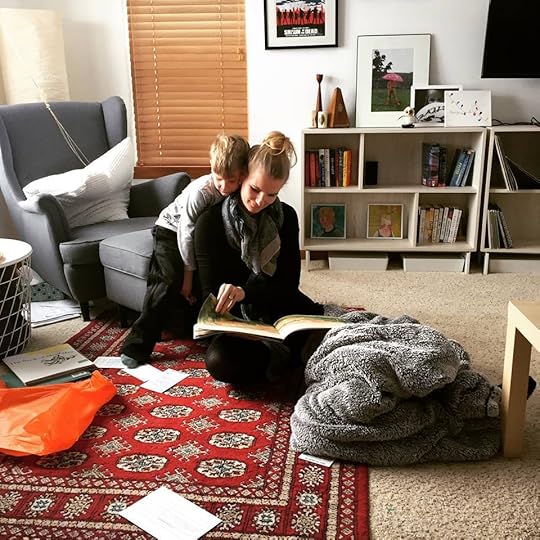
Oskar and I reading a book together in our messy living room – this was hyggeligt
Filed under: being a teacher, being me


March 16, 2017
An Exploration Into Found Poetry
My students don’t love poetry. I know this because when I told them we would be creating poetry, the cacophony of noise that erupted was not one of joy or happiness. It sounded more like some of them were sick.
But this is exactly why I love teaching poetry in 7th grade. It is a chance to rewrite and reclaim the whole notion of what poetry is. To help students see that they too can create things with meaning without feeling like poetry is just one more thing they are not smart enough to produce.
So instead of “regular” poetry, we create found poetry. Introduced to us by the amazing David Daniel, an actor who does a weeklong poetry workshop with us every year (the kids have no idea how much they will love it). We create poetry out of words that were not made by us. We make poetry out of our surroundings, out of noises, out of words found in books and on books. And I see the change, I see the spirit with which kids embrace this task. How they all of a sudden feel like poets.
What are the different components?
Video:
Every day we share a video of a spoken word poet, some of our favorites are – if you have others, please share them in the comments:
To This Day Project by Shane Koyzcan
What Kind of Asian Are You? by Alex Dang
Somewhere in America by Belissa Escobedo, Rhiannon McGavin, and Zariya Allen
An Ode to Whataburger by Amir Safi
Why I Hate School But Love Education by Suli Breaks
Different Concepts:
There are many ways to create found poetry, here are a few of our favorites
Black-Out Poetry
Where students black the words out on pages of books, leaving only the words of their poem behind. We use discarded library books for this.
[image error] [image error]
Found Words Poetry
Students search the classroom for words to fill out in a table on a piece of white paper. Once they have filled all of their boxes, they cut them out, put them in the order they want and then glue them down.
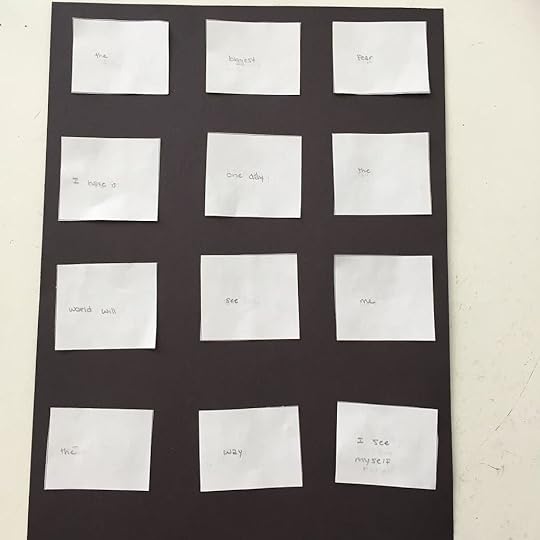
Book Spine Poetry
Students create poetry using the titles of books, by stacking them on top of each other and then snapping a picture of their creations. We shared them on social media using the hashtag #OMSreads

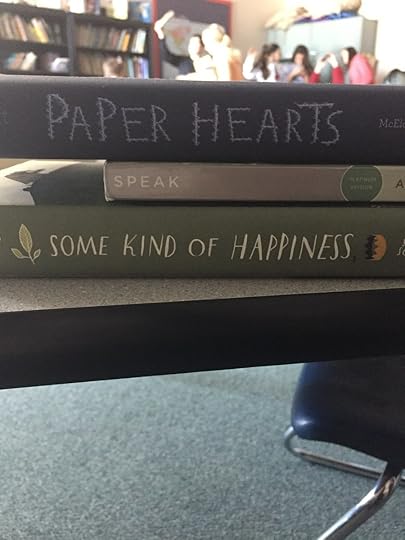
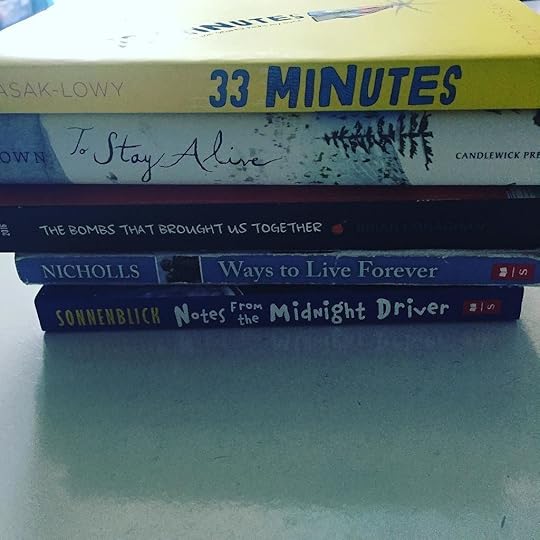
Collage Poetry (or Ransom Note poetry as the students coined it)
Using images and words from magazines, students cut out what they need and create a poem collage.
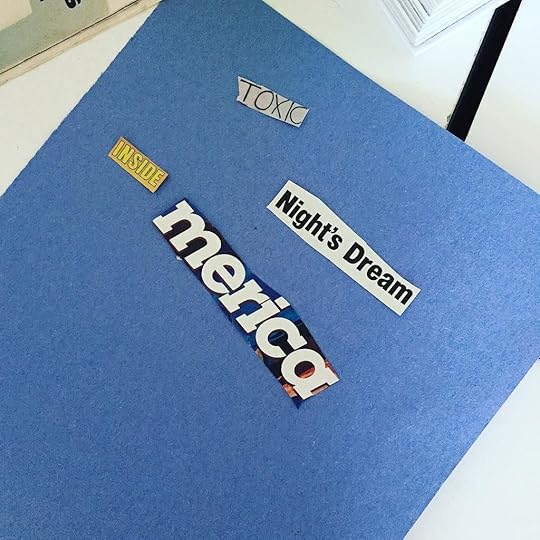

Conversation poetry
Send students to a busy area listening for sounds and snippets of conversations. Write them down and then use them as lines in your poem.
Model poetry
Who says poetry needs words? Using maker space materials create a visual poem that tells its stories using words or not.
There are many other ways of creating found poetry, if you have other ideas, share them in the comments.
While this may seem like just fun and games, it has been quite amazing to see the transformation. We have also spoken about poetic terms that the students have been exposed to before, but may have forgotten. This great word wall came from our 8th grade English teachers and help kids get reacquainted with terms they may either need or would like to be inspired by.
[image error]
So while my students didn’t love poetry in the beginning, and some might not still, many have realized that can be poets. That poetry should make them feel something. that poetry can be all around us. I have loved this exploration so much.
If you like what you read here, consider reading any of my books; the newest called Reimagining Literacy Through Global Collaboration, a how-to guide for those who would like to infuse global collaboration into their curriculum, was just released. I am currently working on a new literacy book, called Passionate Readers and it will be published in the summer of 2017 by Routledge.If you are looking for solutions and ideas for how to re-engage all of your students consider reading my very first book Passionate Learners – How to Engage and Empower Your Students. Also, if you are wondering where I will be in the coming year or would like to have me speak, please see this page.
Filed under: being a teacher, Literacy, writing


March 14, 2017
On Turning Older
[image error]
Birthday card from a student today – one year closer to death, I love it
I turned 37 today.
Every year I receive an email from myself on my birthday, a letter from the previous birthday reminding me of what is important. Asking myself the questions we tend to ponder when our birthday rolls around and our own mortality becomes more apparent.
This year I noticed the pattern; are you slowing down? Are you relaxing? Are you eating better? Are you exercising more? Like the ghosts of long lost new years resolutions, my birthday letters have become reminders of what I should be doing but don’t.
As I see my children grow older, I feel my own years adding up. I don’t feel old, but I know in the eyes of my kids, I have never been young. I have never been a teenager, nor an early twenty-something who had no idea what her future would hold. Instead, I have always been Mom, someone who seems to have many things to do and who sometimes raises her voice or is tired. Who sometimes misses that amazing dance move or that quiet moment playing. Who sometimes tries to be everywhere at once and thus ends up being nowhere. Who never misses the big moments, but is sometimes absent from the small. Who carries more guilt about how she uses her time than should be allowed for anyone.
And so as I drove home this evening after a day of celebration, it struck me that perhaps I am going about this whole life thing a little bit wrong. That perhaps it is not about changing habits, although, I should do all of those things, that perhaps it is, instead, about changing my attitude.
Perhaps the change I need to make this year is not to do less work, but instead to enjoy the things that I do more.
Perhaps it is not to slow down, after all, when does that really work for most people, but instead to live in the moment of what I am doing and find pleasure in that. Because is it not in the mundane details that our lives are lived?
To stop feeling so guilty and instead embrace the things I am doing rather than pining away for the ones I am not.
So for the year ahead, I will enjoy more. I will not try to fight the battle against time or carry the guilt of all of the habits I cannot seem to change. I will find the pleasure in what life has to offer, even the details we seem to never notice and be at peace with that. Be at peace with myself. That is the gift I can give myself right now. And for right now; that will be enough.
Filed under: being a teacher, being me


March 11, 2017
It’s On Us
[image error]
We know we set the mood of our classrooms.
We know that the power we have to make a day better or worse is immense.
We know that what we think about a kid, or a class, sometimes matters more than what we actually do. After all, kids can read us in ways we have yet to fathom.
So when I had gotten stuck on a class being negative. When I had formed a narrative in my mind that a class was never excited to come to English. When I had decided that this was my least engaged class, I was right. Because the moment I decided it, it became true.
Kids will gladly live up to what we believe they are.
And every day I would think of ways I could get the kids to change.
Every day I would think of ways to re-engage them. To discuss with them what the room felt like. To ask them how we could get better.
This went on for months. Wrack my brain to come up with ways to make it a “better” class, yet dreading the energy of the room. I even told others that I didn’t know what to do.
One day, after I had asked the class what else we could try, a child asked me this, “Is it all of us, Mrs. Ripp? Is it me…”
For some reason, I didn’t know what to say. It took me a while at least and finally, I realized that when I told him “It was the energy of the class…” I had lied.
It wasn’t them.
It was me.
I was the one that had determined the fate of this class.
I was the one that had shaped the narrative of our community and the kids, while responsible too, could not do anything to change my mind.
And so I took a moment at home and realized that what I had pegged as negative energy, was just 7th graders being calm.
That what I had taken as disengagement was instead a quiet pondering of facts.
That what I had taken as hating English, instead was an investment, albeit a quiet one, into learning deeply.
My class wasn’t a negative class, it was a chill class, and as a 7th-grade teacher, I was not used to that. I created a problem, breathed in the narrative, and then looked for evidence to back it up. It wasn’t the kids, it was me.
So before we blame the kids.
Before we blame the class.
Before we assume there is nothing we can do because we have tried everything. Stop. Look at yourself. Look at what you have determined to be true and then what you are doing to make it true.
We hold more power than we can ever imagine, let us never forget that.
If you like what you read here, consider reading any of my books; the newest called Reimagining Literacy Through Global Collaboration, a how-to guide for those who would like to infuse global collaboration into their curriculum, was just released. I am currently working on a new literacy book, called Passionate Readers and it will be published in the summer of 2017 by Routledge.If you are looking for solutions and ideas for how to re-engage all of your students consider reading my very first book Passionate Learners – How to Engage and Empower Your Students. Also, if you are wondering where I will be in the coming year or would like to have me speak, please see this page.
Filed under: Be the change, being a teacher


Can We Please Stop Grading Independent Reading?
“But how do you grade their independent reading?”
I am asked this question while presenting on how to create passionate readers.
I am stumped for a moment for an answer. Not because I don’t know, but because we don’t. Why would we? And yet, it is a question I am asked often enough to warrant a decent response.
My middle school does not issue a grade for how many books a child has read. For how many minutes they have read. For how far they have gotten on their book challenge goals.
And there is a big reason for this.
How many books you read does not tell me what you can do as a reader. How long you can sustain attention to a book may tell me clues about your relationship with reading but it will not tell me where you fall within your reading skills. Actual skill assessment will do that. Explorations where you do something with the reading you do will tell me this. The amount of books you have read will not tell me what you are still struggling with or what you have accomplished. Instead it will tell me of the practice you do with the skills that I teach you. With how you feel about reading in front of me and when I am not around. About the habits you have established as you figure out your very own reading identity. These habits are just that; skills you practice until something clicks and it becomes part of who you are. Those are not gradeable skills but instead a child practicing habits to figure out how to get better at reading. A child figuring out where books and reading fits into their life.
So just like we would never grade a child for how many math problems they choose to solve on their own, how many science magazines they browsed or how many historical documents they perused, we should not grade how many books a child chooses to read. We should not tie pages read with a grade, nor an assessment beyond an exploration into how they can strengthen their reading habits. Number of books read, minutes spent, or pages turned will never tell us the full story. Instead it ends up being yet another way we can chastise the kids that need us to be their biggest reading cheerleaders.
So when we look to grade a child on how they are as a reader we need to make sure that the assessments we provide actually provide us with the answers we need. Not an arbitrary number that again rewards those who already have established solid reading habits and punish those that are still developing. And if you are asked to grade independent reading, ask questions; what is it you are trying to measure and is it really providing you with a true answer? Are you measuring habits or skills? Are the grades accurate? If not, why not? And if not, then what?
PS: And for those wondering what we do assess in our reading, here is a link to our English standards.
If you like what you read here, consider reading any of my books; the newest called Reimagining Literacy Through Global Collaboration, a how-to guide for those who would like to infuse global collaboration into their curriculum, was just released. I am currently working on a new literacy book, called Passionate Readers and it will be published in the summer of 2017 by Routledge.If you are looking for solutions and ideas for how to re-engage all of your students consider reading my very first book Passionate Learners – How to Engage and Empower Your Students. Also, if you are wondering where I will be in the coming year or would like to have me speak, please see this page.
After all, we
Filed under: Be the change, being a student, being a teacher, Literacy, Reading, Reading Identity, student choice, Student dreams


March 9, 2017
Introducing Passionate Readers – My New Book
When I moved to 7th grade English, I didn’t know how much this change would affect me. How I would spend more hours than I had ever spent trying to help all of my students like reading more. How their reading truths would shape me as a teacher. How there would be lost sleep, but also triumphant moments of knowing that what we did together made a difference to a kid. That what we did together meant that a child might actually keep reading or even start back up.
I have shared our experiences here. I have spoken about it wherever I have been invited. I have taken the words of my students and held them up for others to learn from because they have taught me so much. Through their insight, I was able to become a better teacher, even if I still don’t have all of the answers.
And so I wrote a book. A book to hold all of their ideas. A book to hold all of mine. A book to take the ideas of others that have pioneered better reading instruction and meshed it with what we are asked to do within our English instruction, within our 45 minutes, within the confinement and the pressure we feel.
I have poured every ounce of truth that my students gave me into this book and this book is now ready for the world. Or, almost ready. With a release month of July – the book is written and now I am ready to reveal its cover. So world; meet the book that I hope helps others. Meet the book that I hope will be a game changer for those who need it. Meet the wisdom of the kids from room 235D and may their words be a light for you as they were for me. To pre-order your copy, go here.
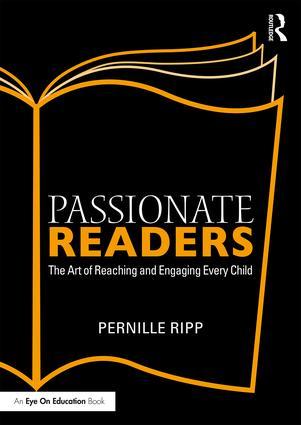
Filed under: being a teacher, being me


March 6, 2017
In Favor of the Slow Learning Movement
We have been going kind of slow these days in room 235D. Taking our time. Finding our groove, digging in, digging deeper. Talking more, asking more, and sometimes even relishing the calmer, quieter new us. Well, calm to an extent, this is after all 7th grade.
It’s not that our curriculum disappeared. It is not that our time expanded (still 45 minutes to teach everything!). It is not that I figured out how to cram more into the heads of the children I get to teach in the time we have. I didn’t flip, I didn’t give them more homework, I didn’t hand them all of the work to do on their own and then finally got to the point. No, the truth is much simpler; we have slowed down our learning.
We have cut out the extra.
We have cut down on the projects.
We have cut down on whole class instruction.
We have taken our time with a few things. We have taken extra days when we needed. We have taken detours when we needed. I have stopped and listened better to the students in front of me and then tried to adapt to their needs. It is a luxury, sure, but it is also making a difference.
Gone are all of the extra little projects that I would try to squeeze in just to make sure they understood. Gone are the small assignments where I check for understanding. Gone are the days where we seemingly jumped from one thing to another, hoping to find time for the bigger learning at some point.
The projects we do now count for more standards. Take longer with all the work-time built into our class time. I circle or pull small groups. The teachers that support our kids also work with small groups. Anyone can join us, no stigma attached.
And the kids? They are understanding more. They are calmer. They are grasping the importance of some of the work we do, and also finding it easier (hallelujah). They leave happier. They leave more invested.
And me? I feel like I am a better teacher. Like what we are doing is actually making a difference. That they are growing more as learners. That all of the knowledge I want them to explore and even be able to apply is within their grasp, if not already conquered.
We have realized that by doing less, we actually learn more.
So what can you do to join the slow learning movement?
Cut out the extra. What are the nonessentials crammed into your schedule? What are the things you value most? How can you find more time for the things that matter and give less time to the things that do not? I realized that while there were certain things that I would like to do, such as a quick write every day, that within our 45-minute framework they did not make sense. So I let them go; what can you let go?
Make a project count for more. We are standards-based and so it is common that our projects and explorations count for more than one standard at a time, but I have also been purposeful in planning this. So the projects we do now tend to count for three or even four standards, all graded separately. This way I do not need to create as many different opportunities for the students to show their understanding. This way students can focus on one longer project and go deeper with it.
Remember that when students speak, more learning happens. I have really been working on letting student conversations run their course rather than rushing them through it. This is where the connections are being made, this is where the understanding broadens. So before you ask the next question or move on to the next task; wait a moment and let them continue to speak. Listen in and even let silence fall for a few seconds, you may be surprised at what other thoughts are shared.
Keep the larger purpose in mind and front and center. All year I refer to the same goal that I have for our English class; for the students to become better human beings. This is something I refer to often and also tie in with our curriculum. So when we write, we do it to be able to be better storytellers who can influence others, when we speak it is to understand, when we listen it is to build connections with others. While the projects may change, everything we do is to be better than when we started, and that includes me.
Know your students. I teach 136 students, I think. It takes months to get to know the kids and, in fact, there are still kids I feel I barely know, but I am trying. So to know your students, you have to ask your students; what do you need from me (be prepared that sometimes they do not know), how can I support you, what will be helpful to you if we have to get to this point? By asking my students, I can read their moods and modes better. I can slow down further if needed, I can let them loose when needed. I can scaffold and cheerlead at the same time. And I can help them know themselves.
This year I swore it would be the year of less rush, of less get-it-done, of less “more, more, more.” And it has been, and it is working, and I can tell that my heart no longer pounds as quickly when the day gets started. We laugh more. We learn more. We are more because we do less. How can you find the time to slow down as well?
If you like what you read here, consider reading any of my books; the newest called Reimagining Literacy Through Global Collaboration, a how-to guide for those who would like infuse global collaboration into their curriculum, was just released. If you are looking for solutions and ideas for how to re-engage all of your students consider reading my very first book Passionate Learners – How to Engage and Empower Your Students. I am currently working on a new literacy book, called Passionate Readers and it will be published in the summer of 2017 by Routledge. I also have a new book coming out December, 2017 . Also, if you are wondering where I will be in the coming year or would like to have me speak, please see this page.
Filed under: Be the change, being a teacher


March 1, 2017
Small Wins
I was out of school yesterday. My husband strained his back and since he is a stay-at-home dad that meant that all of a sudden my own kids needed me more than the kids at school. It was our first day back after a three-day weekend and you know how sometimes things go wrong on that first day back after a three-day weekend? Well, yeah, some things went wrong. And yet…
When I returned to our classroom today, I was met by cheers. “You are back, Mrs. Ripp!””How is your husband?” “Why weren’t you here with us?” As I got them up to speed, we quickly got to work; book shopping to be done, self-reflections to fill out. A day full of busy, much like any other day, and a day full of small wins.
From the child that knew just to grab a pencil rather than ask if they could borrow one, to the child that told me to please hide the new book in the pile because he had already started reading it.
To the girl who gushed about a book I held up to make sure others read it, to the boy who told me he was proud of how he had challenged himself.
Four kids all racing in after 7th hour to grab the same book and telling me that the others better read it fast because they have to read it now.
A child simply telling me thank you when I helped him.
Being given the chance to hand a child an assignment back that they had done so well in and seeing the moment they recognized their own achievement.
From the girl that kept trying and finally did, to the boy who told me he had found a way to stop his pen tapping, to the boy who told me that in our class he does well.
Those are the moments that followed me home. Those are the moments that matter. Because while we may look at the big picture of the year and wonder how far we still have to go, the truth lies in those small wins where we really see how far we have come.
To all of my kids today, I am so proud to be your teacher.
If you like what you read here, consider reading any of my books; the newest called Reimagining Literacy Through Global Collaboration, a how-to guide for those who would like infuse global collaboration into their curriculum, was just released. If you are looking for solutions and ideas for how to re-engage all of your students consider reading my very first book Passionate Learners – How to Engage and Empower Your Students. I am currently working on a new literacy book, called Passionate Readers and it will be published in the summer of 2017 by Routledge. I also have a new book coming out December, 2017 . Also, if you are wondering where I will be in the coming year or would like to have me speak, please see this page.
Filed under: Be the change, being a teacher


February 28, 2017
Books That Teach Us About the Experience of Refugees and Immigrants
This year in English we have really been focused on learning about others. Others whose life experience may be so very different from our own. Others who have so much to teach us. Others who some may tell us to fear. So our collection of chapter books and books have grown with a focus on breaking down biases and broadening understanding. I, therefore, thought that it would be helpful for others to see which books have helped us do just that. Many of these books have been on other lists that I have posted, but there are a few new ones.
Picture books
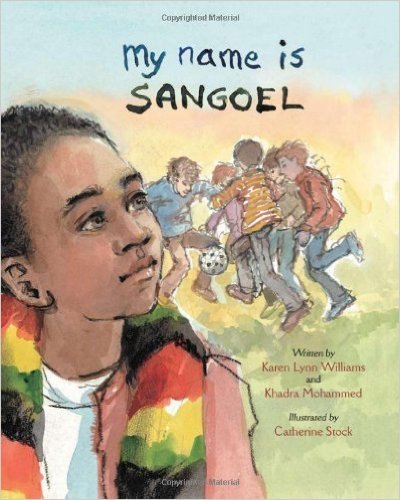
My Name Is Sangoel by Karen Williams (Author), Khadra Mohammed (Author), Catherine Stock (Illustrator)
What’s in a name? As educators, we know the inherent power of pronouncing a child’s name correctly to make them feel accepted and included. This picture book from 2009 shares the story of Sangoel, a refugee from Sudan, and what happens when he comes to America. A must add as we try to break down walls and build understanding for others in our classrooms.

The Journey by Francesca Sanna (Illustrator)
One of the most powerful picture books to be published in 2016, The Journey is about a family as they flee from war and the decisions they have to make as they search for safety. Beautifully illustrated this picture book packs a punch.
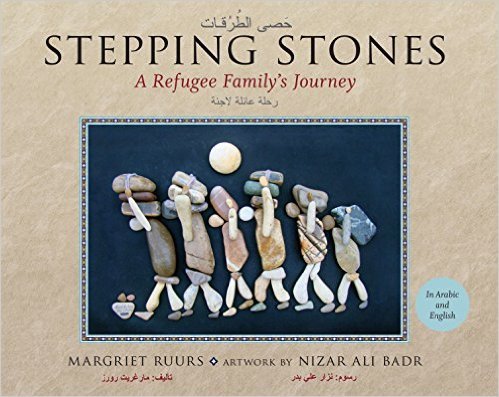
Stepping Stones: A Refugee Family’s Journey (Arabic and English Edition) by Margriet Ruurs (Author), Falah Raheem (Translator), Nizar Badr (Artist)
Also a picture book about a family that has to leave their country in search of safety, the artwork is all done by stone. With both English and Arabic text, I am so grateful for the vision of this picture book.
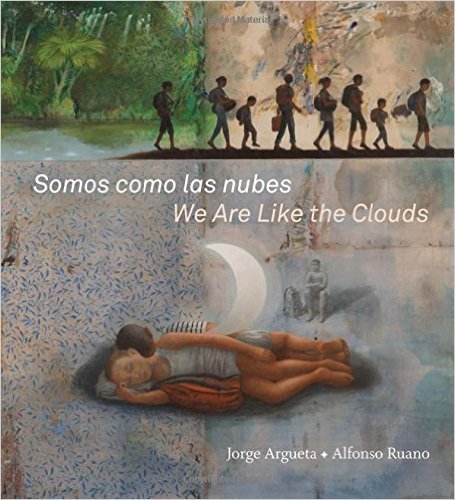
Somos como las nubes / We Are Like the Clouds by Jorge Argueta (Author), Alfonso Ruano (Illustrator)
Why would a child set out on foot toward America, knowing that there were thousands of miles filled with danger ahead of them? This picture book illustrates the journey that more than 100,000 children have taken as they try to reach safety in the United States. Told in poetry, this picture book helps us understand something that can seem inconceivable.
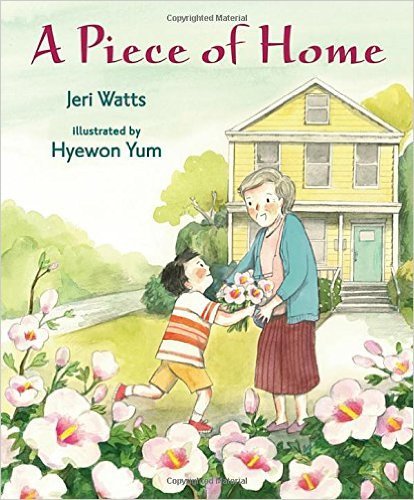
A Piece of Home written by Jeri Watts and illustrated by Hyewon Yum
Fitting in. Feeling lost. Appreciate differences. What happens when a family chooses to move to the US and all of a sudden does not fit in anymore?
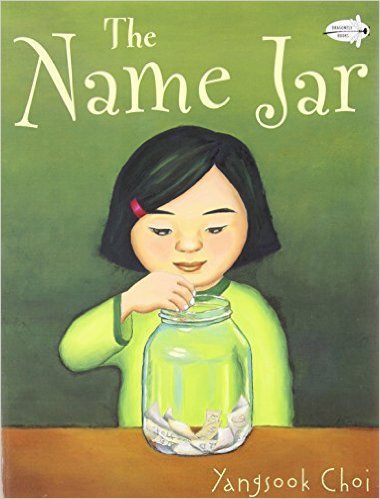
The Name Jar by Yanksook Choi (Having a name that no one pronounces correctly in the USA really makes me love this book even more).
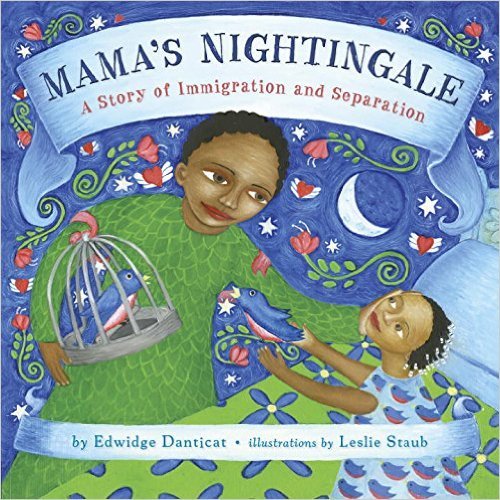
Mama’s Nightingale: A Story of Immigration and Separation by Edwidge Danticat (Author), Leslie Staub (Illustrator) brings us the story of a little girl’s longing for her mother as they are separated. The mother has been sent to a detention center and does not know what will happen to her.
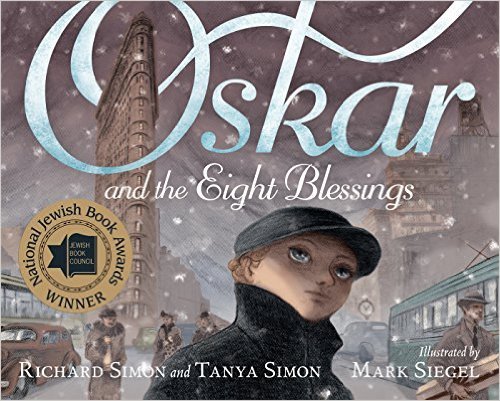
Oskar and the Eight Blessings by Tanya Simon (Author), Richard Simon (Author), Mark Siegel (Illustrator)
Sharing the story of Oskar, a young boy who has escaped the horror of the Jewish persecution in Germany and arrives in America with only a photograph and an address of an aunt he has never met. He must make his way through the streets of NYC, but rather than being afraid, he sees the blessings he meets along the way. Another must add as we discuss refugees, and not being afraid of others in our classrooms.
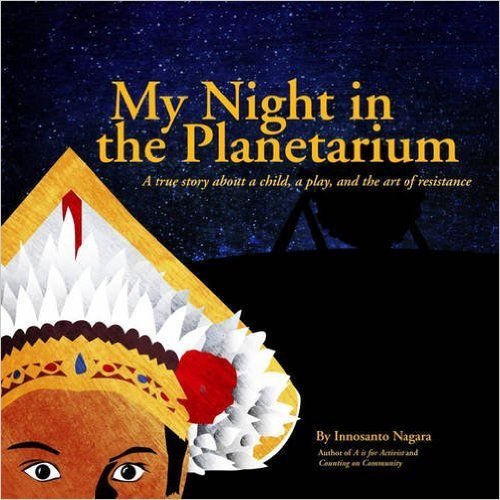
My Night in the Planetarium by Innosanto Nagara (Author)
Taken from his own life; this story of having to hide in a planetarium as the government looks for his activist father is one sure to get students talking. What happens when you speak up but the government does not want you to. Reminding us that even when it is scary, we should still stand up for what is right, and sharing the story of why some people have to flee, this is another must-add to your collection.
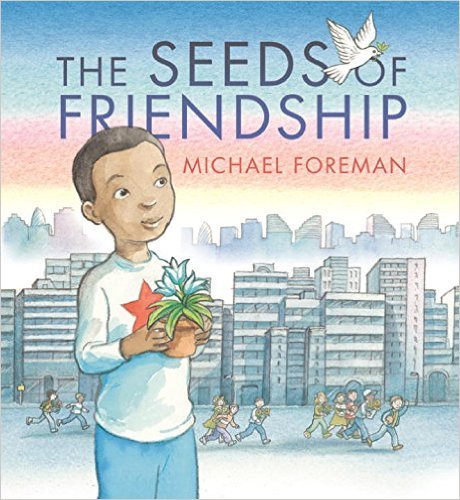
In The Seeds of Friendship by Michael Foreman a boy is not sure how to make a connection with others. That is until he is given seeds and he has an idea of how to make this new gray city more like home.
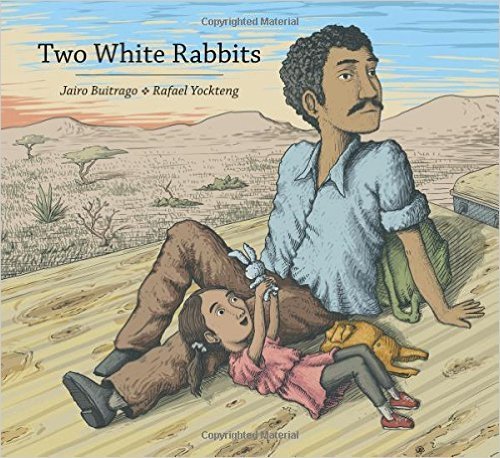
What happens when a father and his young daughter set out toward the border? In
Two White Rabbits by Jairo Buitrago (Author), Rafael Yockteng (Illustrator), Elisa Amado (Translator) we are given the perspective of the migrants that do just this.
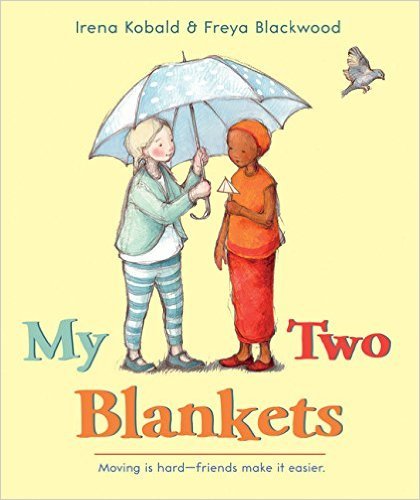
My Two Blankets by Irena Kobald and Freya Blackwood speaks to how hard moving is, but also about finding a new friend. This is all about finding the beauty in someone else’s culture.
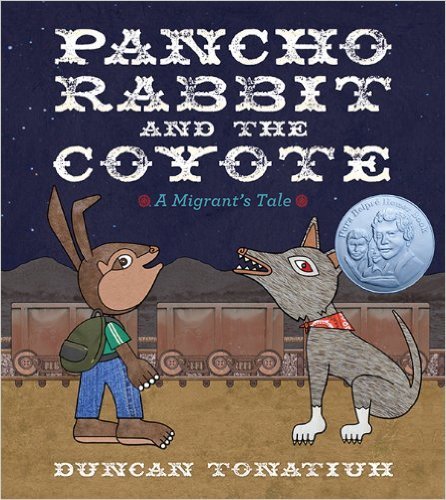
Pancho Rabbit and the Coyote: A Migrant’s Tale by Duncan Tonatiuh. This allegory tells the tale of Pancho who is waiting for his father’s return from the north. When Papa doesn’t show up as expected, Pancho is determined to find him. The author, Duncan Tonatiuh, is a Global Read Aloud contender for picture book study.

In Grandfather’s Journey by Allen Say I am reminded of how split we can feel when we belong to two countries. Beautiful and still relevant more than twenty years after its release, this is a wonderful way to discuss what it means to feel home.

Sometimes the books that tell us the most do not even have words. The Arrival by Shaun Tan a wordless graphic novel/picture book is one that will mesmerize readers.
Chapter books

Outcasts United: The Story of a Refugee Soccer Team That Changed a Town
by Warren St. John. This story of a how a youth soccer team changed attitudes of a southern town is a great conversation starter. What are the biases we have and how can find our similarities rather than our differences?

This list wouldn’t be complete without the Newbery-winning Inside Out and Back Again by Thanhha Lai. Following a Vietnamese family as they re-settle in the United States, this book is a powerful invitation into how we treat others.

All the Broken Pieces by Ann E. Burg is another free-verse novel that follows the story of Matt Pin, a Vietnamese child brought to the US during the Vietnam War. The story follows him as he tries to make sense of his own past while being confronted by the past of others.

This Global Read Aloud contender for 2017 packs a powerful punch. Home of the Brave by Katherine Applegate follows Kek as he comes to the US without his mother after fleeing the Civil War in his home country. This free-verse book is one that will resonate with many children.

A Long Walk to Water: Based on a True Story by Linda Sue Park is one of those books that sticks with you for a long time after yea read. Based on the true story of Salva and his experience as a Lost Boy of Sudan, whenever students read this book they inevitably have more questions and these questions always lead to a broader understanding of the world and more empathy toward others.

Set in Sudan and following the story of Amira, a twelve-year-old who wants to go to school against her mother’s wishes, this is a book that helps many of my students understand how much they have in common with other children. The Red Pencil by Andrea Davis Pinkney (Author), Shane Evans (Illustrator) is also a Global Read Aloud contender.
On My Wish List

Lost and Found Cat: The True Story of Kunkush’s Incredible Journey
by Doug Kuntz (Author), Amy Shrodes (Author), Sue Cornelison (Illustrator)
This new picture book may just have snuck its way into my cart as I looked up book covers. How amazing does this story look?

Alan Gratz is a master story teller and a perpetual student favorite, I have therefore already pre-ordered his newest book Refugee which comes out in July. I am so thankful for the research he does and the stories he writes.
For more books, many I have not yet discovered myself, go here:
30 Multicultural Picture Books about Immigration
ALA’s impressive list of books
I know there are more books so I will update this list when I go through my classroom library. Please share your titles in the comments below.
Filed under: being a teacher, books, global, global read aloud, Literacy, picture books, Reading


February 25, 2017
The Reading Identity Challenge
[image error]
At the beginning of the year, I asked my students to tell me how they felt about reading. I do this every year as it offers me a baseline, a glimpse into their reading truths. I was not surprised at the results, 25% told me they loved it, 50% told me they didn’t mind it, and the final 25%? They told me they hated it. Perhaps slightly higher than normal, but nevertheless, teaching 7th graders, I was not worried. After all, every year it seems this happens and every year, children change their minds.
This year, though, some have proven to be stubborn. Those kids that hate reading, they still were fighting me every step of the way. Abandoning books, which we do embrace, every single day. Refusing to book shop even. Flipping pages aimlessly day in and day out. Not having any desire to change their hatred, content with being part of the statistics of kids that don’t read.
So I created the Student Reading Identity Challenge. Not just for the kids who still hated reading, but for those that needed a spark, those that needed to stretch their reading legs a little. For myself to challenge my own reading life, nervously glancing at Hatchet and Roll of Thunder, Hear My Cry as two books I had no desire to read but knew I should.
A reading challenge for us all, so we all could get better, whatever better meant to us. The concept is simple; over the course of three weeks or so students would select one aspect of their personal reading life and challenge themselves to make it better or change it. Much like a personal goal; there was no right challenge, instead, it was based on the individual’s needs, the hopes for the future. There was no limit to what they could work on and they would be given around twenty minutes every day to read, rather than our usual ten.
We started with this five-page survey; yes, five pages. I needed students in all their stages of reading relationship to uncover new truths about themselves. It needed to go beyond whether they liked to read or not and into their actual reading habits. Where are they reading, what are they reading, why are they not reading more? Where are their book gaps? Where do they get book recommendations from? All those little things that play into who they are as a reader. It took the kids almost two days to fill it out because I asked them to please slow down, please really think about it, and then show your goal to me.
The goals varied; I want to enjoy reading again, I want to try a new genre, I want to read every day. Some couldn’t think of one until we looked through all of their answers and something jumped out at us. Whatever the goal was there was a reason, a personal one, that this was the one thing they felt would help them become a better reader. Some kids even chose a read aloud with another teacher so they could have a shared experience around a book, trying to help them actually like reading more. For every goal there was a story; a story of reading blossomed or reading gone wrong. For every goal there was either excitement or reprehension; how would this actually change anything? Once all the goals were in place, I asked the kids to somehow keep track – how will you know you are working on your goal? Some chose a calendar to write down minutes or rank their reading of the day, some chose a peer to speak about their reading. This is the one component I am still working on, I did not want it to be a writing experience, one where the students would have to jot down their thoughts every day, but instead, an organic process for them that helped them have a great experience, not one more thing to do.
[image error]
So we began; some kids book shopped the first few days, having to find a great book as part of their goal as well, others dove right in. I taught a mini-lesson every day and then the rest of the time was for them to read. I pulled small groups, conferred with students, and otherwise watched. Were they actually reading? Was this actually working…
One child told me she was so confused in her fantasy book and this was exactly why she never read fantasy because “It doesn’t make any sense!” and yet because of the challenge she read on, declaring at the end of the book that she couldn’t wait for the sequel. Another told me she was stuck in the boring part and this was always when she abandoned a book, but now because of the challenge, she read on. A child who has yet to read a single book this year, no matter my support, is on page 60 of Hatchet, telling me yesterday that he read 20 pages in one day.
Whatever their goal, I saw it gradually start to happen; kids finding a way to make reading better for themselves. Kids realizing more deeply who they are as readers, where they are on their reading journey. For some, it has proven to be a huge revelation, for others just a small one. But for most, it has changed something in them as a reader. For most, there is a deeper urge to make reading enjoyable, no matter what they are reading.
So yesterday, I taught my first two classes, followed my lesson plan to the tee. But in my 5th hour, the students asked if they could please read for ten minutes today, knowing I had only allocated ten. Of course, I said. When the fifteen were up, they asked for five more minutes. Of course, I said. When the five were up they asked if they could please just read the rest of the class. As twenty-five students stared at me, seemingly holding their breath, I said, “Of course.” And then watched the thickest of silences fall over the room as they each retreated into their books. Even the ones who tell me they hate reading. Even the ones who used to flip pages. I did the same for the rest of my classes, and it didn’t change; silence, except for the pages being turned, and one child telling me triumphantly that they had read fifteen pages today – more than they read all of last week.
The reading identity challenge is not the end all be all, but it is another step in helping students uncover another aspect of who they are as readers. It is another tool to help them become empowered in their own reading journey. It is another step to tell all of my students that reading matters and that they control so much of their relationship with reading. That new genres await, that it is possible for reading to be fun, that they can make it through the boring parts, that they can go deeper in their text. That reading should be a part of who they are and therefore also should be something they mold and shape as they develop further.
As for me? It turns out that Hatchet and Roll of Thunder, Hear My Cry were amazing books. That I have realized that perhaps I should be looking at other classic children’s book gaps to make sure I am able to recommend them to kids. That even though I love reading, I still have things to work on. Just like my students, just like we all do.
If you like what you read here, consider reading any of my books; the newest called Reimagining Literacy Through Global Collaboration, a how-to guide for those who would like infuse global collaboration into their curriculum, was just released. If you are looking for solutions and ideas for how to re-engage all of your students consider reading my very first book Passionate Learners – How to Engage and Empower Your Students. I am currently working on a new literacy book, called Passionate Readers and it will be published in the summer of 2017 by Routledge. I also have a new book coming out December, 2017 . Also, if you are wondering where I will be in the coming year or would like to have me speak, please see this page.
Filed under: being a teacher, Literacy, Reading, Reading Identity, student choice, Student dreams, student driven, Student Engagement, student voice, Student-centered





